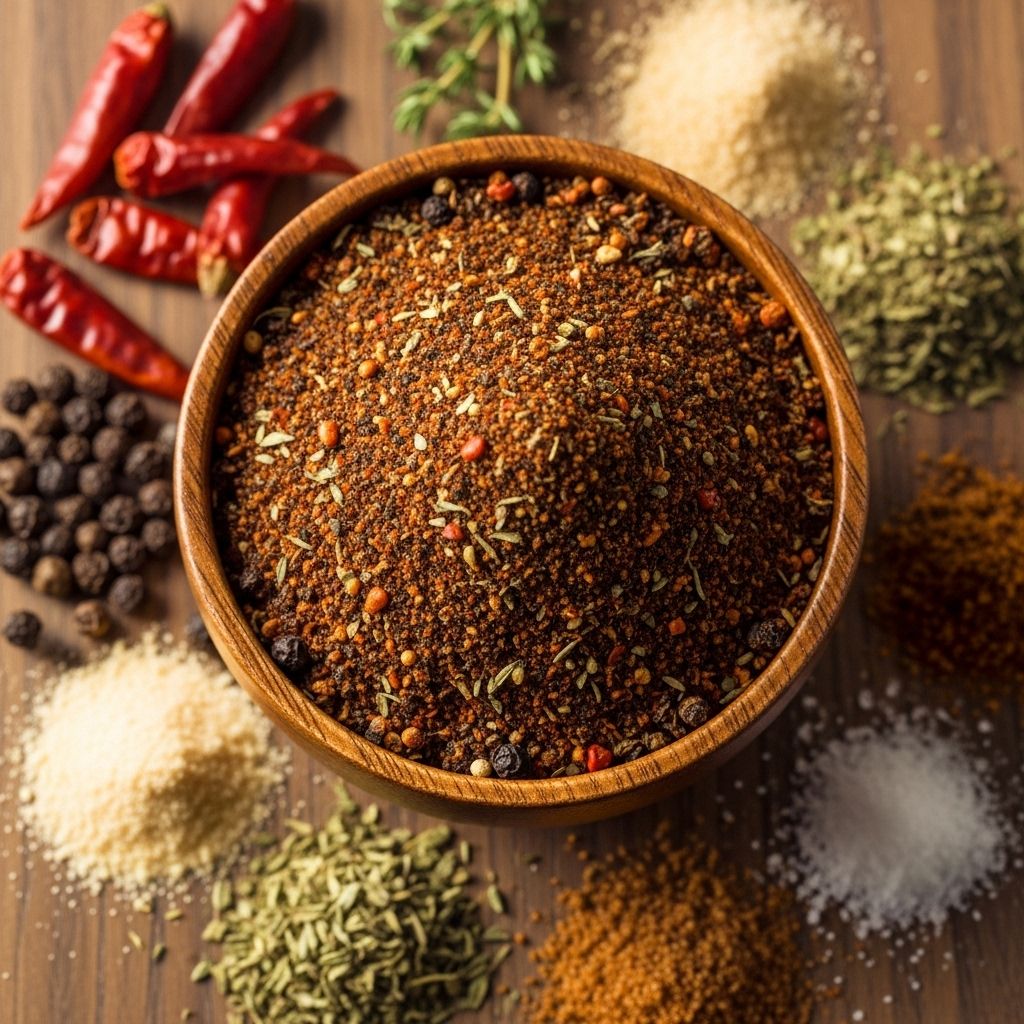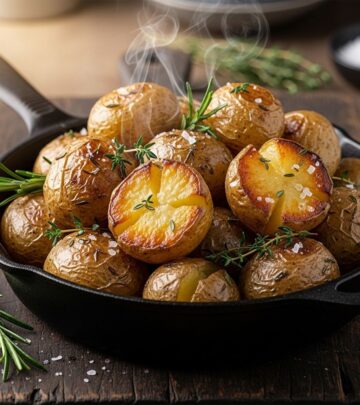Blackened Seasoning Recipe: 8 Ingredients For Bold Flavor
Unlock bold, spicy flavors in your kitchen with this easy, customizable blackened seasoning mix recipe.

Image: HearthJunction Design Team
Homemade Blackened Seasoning Mix: The Ultimate Guide
Spice up your kitchen adventures with an easy, flavorful homemade blackened seasoning mix. Whether you love Cajun, Creole, or simply crave a punch of heat and aromatics, mastering this blend can transform ordinary dishes into bold, unforgettable meals. This comprehensive guide will walk you through the ingredients, method, usage tips, comparisons with similar spice blends, and answer common questions to ensure your blackening experience is a fiery success.
What is Blackened Seasoning?
Blackened seasoning is a robust spice blend popularized in Cajun and Creole cooking, known for its spicy character and depth of flavor. Traditionally used to coat proteins before searing at high temperatures, it creates a signature blackened crust — a result of the Maillard reaction when spices, herbs, and butter meet intense heat. Its flavor is a harmonious mix of smokiness, peppery heat, and herbaceous undertones.
Ingredients for Blackened Seasoning Mix
This simple recipe yields a versatile blend ideal for chicken, fish, shrimp, steak, tofu, and vegetables. All ingredients are pantry staples, making it easy to whip up a batch at any time.
- 1 ½ tablespoons paprika – The smoky, sweet base of the blend.
- 1 tablespoon garlic powder – Adds savory depth.
- 1 tablespoon onion powder – Brings sweet and earthy flavor.
- 1 tablespoon ground dried thyme – For subtle, woodsy notes.
- 1 teaspoon ground black pepper – Delivers sharp heat.
- 1 teaspoon cayenne pepper – The source of bold spiciness.
- 1 teaspoon dried basil – Lends fragrant, sweet undertones.
- 1 teaspoon dried oregano – Adds pungent, herbal character.
This base recipe yields about 12 servings. For larger batches, simply multiply the ingredient quantities accordingly.
How to Make Blackened Seasoning Mix
- Gather all ingredients.
- Combine spices. In a mixing bowl, add paprika, garlic powder, onion powder, thyme, black pepper, cayenne pepper, basil, and oregano.
- Mix thoroughly. Stir until the spices are evenly combined and you have a uniform mixture.
- Store properly. Transfer the blend to an airtight container and keep it in a cool, dry place to preserve freshness and potency.
Tip: For maximum aroma and flavor, make sure your dried herbs and ground spices are fresh. Old spices can lose their punch.
Why Make Your Own Blackened Seasoning?
- Customizable Heat: Adjust the amount of cayenne to suit your preferred spice level.
- Salt-Free Option: Control sodium by leaving salt out entirely or seasoning separately according to taste.
- No Preservatives: Homemade blends are free of additives and anti-caking agents commonly found in store-bought mixes.
- Cost-Effective: Pantry staples combine to make an ample supply for pennies per serving.
How to Use Blackened Seasoning Mix
This seasoning is exceptionally versatile. Traditionally, it’s used in blackening—a cooking technique where food is dredged in melted butter, generously coated in seasoning, then seared in a hot, heavy skillet (often cast iron) until a flavorful crust forms.
- Fish & Seafood: Blackened salmon, catfish, shrimp, or tilapia all become bold, spicy entrees.
- Poultry: Chicken breasts or thighs get jazzed up with a blackened crust for salads, tacos, and sandwiches.
- Beef & Pork: Try on steak, pork chops, or ribs for a peppery kick.
- Vegetarian Options: Blackened tofu, portobello mushrooms, or roasted vegetables are outstanding meatless recipes.
- Potato Dishes: Toss potato wedges, fries, or roasted cubes with blackened seasoning for a zesty side.
How to Blacken Foods
- Preheat your skillet (cast iron recommended) over high heat until very hot.
- Dredge your protein or vegetables in melted butter.
- Coat generously with the blackened seasoning.
- Place in the skillet and sear without moving for 2–4 minutes per side, until a dark, flavorful crust forms.
Serve immediately. The smoky aroma and spicy crust deliver restaurant-quality taste at home.
Comparing Blackened, Cajun, and Creole Seasoning
| Seasoning | Main Ingredients | Flavor Profile | Typical Usage |
|---|---|---|---|
| Blackened | Paprika, cayenne, garlic, onion, black pepper, thyme, basil, oregano | Spicy, smoky, aromatic herbs | Butter-coated proteins seared at high heat for a ‘blackened’ crust |
| Cajun | Paprika, garlic, onion, cayenne, black pepper, thyme, oregano, sometimes salt | Spicy, simpler with less herbal flavor | General seasoning for meats, veggies, stews, and rice dishes |
| Creole | Paprika, black pepper, garlic, onion, cayenne, thyme, basil, oregano, sometimes bay leaf, rosemary, parsley | Milder heat, more aromatic herbs, complex | Creole dishes, sauces, soups, with a flavor emphasis on aromatics |
In summary, blackened seasoning is often described as a blend between Cajun and Creole, offering both spice and aromatic complexity. Its distinction mainly lies in the high heat cooking method that creates the telltale blackened crust.
Expert Tips for the Best Blackened Seasoning
- Toast Spices: For deeper aroma, gently toast whole spices before grinding and mixing.
- Adjust Herbs: Experiment by swapping in marjoram or sage for different herbal notes.
- Mix Fresh: Grind dried herbs yourself for maximum flavor, especially thyme and oregano.
- Salt to Taste: If adding salt, start with 1 teaspoon per recipe batch and adjust as needed.
- Try Smoked Paprika: For a smokier, more intense base, substitute smoked paprika for part or all of the sweet paprika.
How to Store Blackened Seasoning
Keep your spice mix in an airtight container, away from heat and direct sunlight. A glass spice jar, plastic food-safe container, or resealable bag all work well. Properly stored, the seasoning will maintain its potency for up to 6 months, although the flavors are best in the first 3 months.
Popular Recipes Using Blackened Seasoning
Below are some classic and creative dishes featuring blackened seasoning. Use your homemade mix in place of store-bought blends for fresher flavor and customization.
- Blackened Salmon Fillets: Coat salmon in butter and seasoning, then sear in a hot skillet until a crisp crust develops.
- Blackened Chicken: Use chicken breasts or thighs, seasoned and pan-seared to perfection.
- Blackened Shrimp Tacos: Toss shrimp in seasoning, cook quickly, and serve in tortillas with slaw and crema.
- Blackened Steak: Steak becomes bold and spicy coated in the mix and cooked over high heat.
- Roasted Blackened Vegetables: Toss broccoli, cauliflower, or potatoes in oil and seasoning, then roast for a smoky, spicy side.
FAQ: Frequently Asked Questions
Q: Is blackened seasoning always very spicy?
A: The level of spiciness depends on the amount of cayenne pepper used in the blend. You can easily control the heat by reducing or omitting cayenne, or by mixing in a milder chili powder.
Q: Can I add salt to blackened seasoning?
A: Yes, salt can be added if desired. Starting with 1 teaspoon per batch is a safe guideline, but it’s common to leave salt out to control saltiness in the final dish.
Q: What if I don’t have one of the herbs or spices?
A: The seasoning is flexible. If missing one or two herbs (basil or oregano), increase another herb slightly or simply proceed. The overall result will still be delicious and aromatic.
Q: How long does homemade blackened seasoning last?
A: Stored properly in an airtight container in a cool, dark place, the seasoning lasts up to 6 months. For best flavor, use within 3 months.
Q: Is blackened seasoning gluten-free and vegan?
A: Yes. All the spices and dried herbs are gluten-free and vegan. The blend contains no animal products or wheat-based additives.
Tips and Variations
- Smokier Taste: Use part smoked paprika for a more intense, BBQ-style flavor.
- Less Heat: Lower the cayenne or substitute with mild chili powder for a milder blend.
- Sugar Addition: Some recipes benefit from a pinch of brown sugar to balance heat and bitterness, especially when used on grilled meats.
- Cumin or Nutmeg: Add a pinch for an earthy or warm, nutty note—common in some Cajun-inspired blends.
Conclusion
Making your own blackened seasoning mix at home is an effortless, rewarding way to boost your culinary creations. The blend’s fiery, herbal flavors are endlessly customizable and suitable for a wide range of dishes, from seafood to vegetables. Skip the store-bought options and enjoy bigger, bolder flavor with every sprinkle. Keep this guide handy and experiment with blends until you find your perfect mix!
References
- https://www.allrecipes.com/recipe/174668/blackened-seasoning-mix/
- https://www.allrecipes.com/recipe/64761/toms-blackened-seasoning/
- https://www.allrecipes.com/recipe/36487/blackened-salmon-fillets/
- https://www.allrecipes.com/recipe/8571/blackened-chicken/
- https://www.allrecipes.com/recipe/149221/cajun-spice-mix/
Read full bio of medha deb












